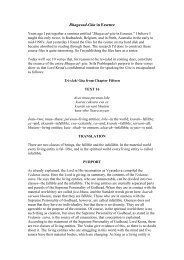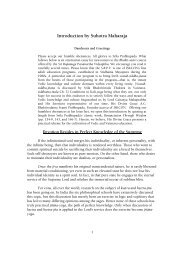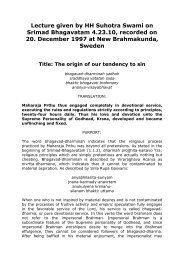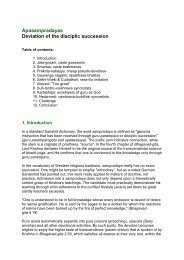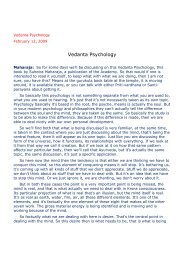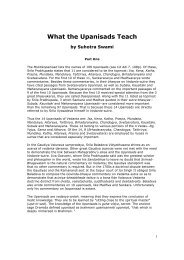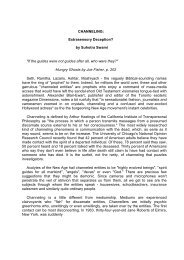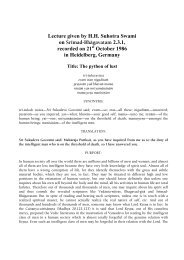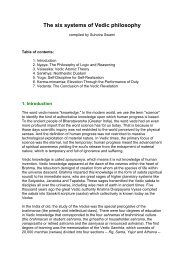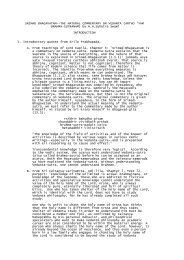Deviant Vaisnava Sects - Suhotra Maharaja Archives
Deviant Vaisnava Sects - Suhotra Maharaja Archives
Deviant Vaisnava Sects - Suhotra Maharaja Archives
Create successful ePaper yourself
Turn your PDF publications into a flip-book with our unique Google optimized e-Paper software.
In Kali-yuga, the present age, there are only four genuine sampradayas wherein<br />
saintly <strong>Vaisnava</strong> association can be found. One of these is the Brahma Sampradaya,<br />
established in South India by the great acarya Madhva. This sampradaya was accepted<br />
by Sri Caitanya Mahaprabhu when He received initiation into the chanting of the Hare<br />
Krsna maha-mantra from His guru, Sri Isvara Puri. Then, in Bengal (Gaudadesa), Lord<br />
Caitanya began His movement of sankirtana, the congregational chanting of the holy<br />
names of Krsna. Lord Caitanya's sankirtana mission, of which the International Society<br />
for Krishna Consciousness is the worldwide exponent, is known as the Brahma-Madhva-<br />
Gaudiya Sampradaya.<br />
Srila Bhaktivinoda Thakura has identified thirteen apasampradayas that claim to<br />
have inherited Lord Caitanya's mission, though they have nothing to do with the Brahma-<br />
Madhva-Gaudiya Sampradaya. They are known by the names aula, baula, kartabhaja,<br />
neda, daravesa, sani, sahajiya, sakhibheki, smarta, jata-gosani, ativadi, cudadhari, and<br />
gauranga-nagari. Because these apasampradayas (apa means "deviated") do not nurture<br />
<strong>Vaisnava</strong> qualities, their missionary activities are condemned as cheating.<br />
As mentioned in <strong>Vaisnava</strong> Ke, by Srila Bhaktisiddhanta Sarasvati, the<br />
apasampradayas display only inauspicious qualities. One is anitya-vaibhava, the<br />
hankering for material success. Another is kaminira-kama, illicit sexual affairs that are<br />
usually passed off as "transcendental." And a third is maya-vada, philosophical<br />
speculation that undercuts the personal nature of God as taught by the <strong>Vaisnava</strong><br />
sampradayas.<br />
What follows is an in-depth look at the deviations of each of the thirteen<br />
apasampradayas. In this article's first installment, two of the most important, the jatagosani<br />
and the smarta, are dealt with.<br />
Caste Gosvamis<br />
The word jata means "by birth" or "by family." Gosani is a Bengali form of the<br />
Sanskrit word gosvami, which means "one who controls his senses." The word jatagosani<br />
is used in a critical sense to refer to those who take the position of gurus only on<br />
the basis of heredity, without having the required spiritual qualifications as well. The<br />
point here is that it is not enough to claim family connections to associates of Sri<br />
Caitanya Mahaprabhu. One must be a pure devotee of the Lord.<br />
The devotees in the Gaudiya <strong>Vaisnava</strong> sampradaya, follow the original six Gosvamis<br />
of Vrndavana. These six devotees, who were all in the renounced order of life, were most<br />
illustrious disciples of Sri Caitanya Mahaprabhu. About these Gosvamis Srinivasa<br />
Acarya has written:<br />
The six Gosvamis—Sri Rupa, Sri Sanatana, Sri Raghunatha<br />
Bhatta, Sri Raghunatha Dasa, Sri Jiva, and Sri Gopala Bhatta—<br />
are worshipable because they renounced their aristocratic family<br />
life as insignificant and became mendicants to preach and



